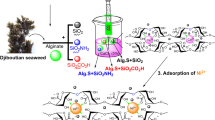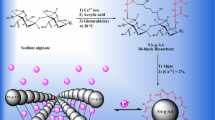Abstract
In this study, microalgae Scenedesmus quadricauda was entrapped in calcium alginate/polyvinyl alcohol composite hydrogel beads by phase-inversion techniques. The composite biosorbents were used for removal of Cu(II) and Cd(II) ions from single component and binary systems using cell-free composite beads as a control system. The effects of the experimental conditions (such as pH, initial metal ions concentrations, temperatures, contact time, and biosorbent concentrations) on Cu(II) and Cd(II) removal efficiencies were studied. The maximum metal ions on the bare and algal biomass immobilized in alginate beads were observed between pH 5.0 and 6.0. The biosorption of metal ions by the bare and composite beads increased as the initial concentration of the metal ions increased in the medium. The biosorption of Cu(II) and Cd(II) on the composite beads appears to be slightly temperature dependent. The maximum biosorptions of metal ions onto microalgae entrapped in composite beads were 0.970 ± 0.028 and 0.682 ± 0.017 mmol/g for Cu(II) and Cd(II) ions, respectively. The equilibrium experimental data for two metallic species fitted well by the Langmuir model. The values of ΔG° at all temperatures are negative, indicating the spontaneous nature of the biosorption process. When the metal ions competed (in the case of the biosorption from their mixture), the amounts of biosorption onto microalgae cells entrapped in beads were 0.857 ± 0.033 mmol/g for Cu(II) and 0.593 ± 0.024 mmol/g for Cd(II). Under noncompetitive and competitive conditions, the affinity order of ions for biosorbents was Cu(II) > Cd(II).







Similar content being viewed by others
References
Akar, T., & Tunali, S. (2006). Biosorption characteristics of Aspergillus flavus biomass for removal of Pb(II) and Cu(II) ions from an aqueous solution. Bioresource Technology, 97, 1780–1787.
Akar, T., Kaynak, Z., Ulusoy, S., Yuvaci, D., Ozsari, G., & Tunali-Akar, S. (2009). Enhanced biosorption of nickel(II) ions by silica-gel-immobilized waste biomass: biosorption characteristics in batch and dynamic flow mode. Journal of Hazardous Materials, 163, 1134–1141.
Arica, M. Y., & Bayramoglu, G. (2009). Construction a hybrid biosorbent using Scenedesmus quadricauda and Ca-alginate for biosorption of Cu(II), Zn(II) and Ni(II): kinetics and equilibrium studies. Bioresource Technology, 100, 186–193.
Arica, M. Y., Arpa, C., Bayramoglu, G., & Genc, O. (2003). Ca-alginate as a support for Pb(II) and Zn(II) biosorption with immobilized Phanerochaete chrysosporium. Carbohydrate Polymers, 52, 167–174.
Arica, M. Y., Bayramoglu, G., Yilmaz, M., Bektas, S., & Genc, O. (2004). Biosorption of Hg2+, Cd2+, and Zn2+ by Ca-alginate and immobilized wood-rotting fungus Funalia trogii. Journal of Hazardous Materials, 109, 191–199.
Artola, A., Martin, M., Balaguer, M. D., & Rigola, M. (2000). Isotherm model analysis for the adsorption of Cd(II), Cu(II), Ni(II), and Zn(II) on anaerobically digested sludge. Journal of Colloid and Interface Science, 232, 64–70.
Bayramoglu, G., & Arica, M. Y. (2008). Removal of heavy mercury(II), cadmium(II) and zinc(II) metal ions by live and heat inactivated Lentinus edodes pellets. Chemical Engineering Journal, 143, 133–140.
Bayramoglu, G., & Arica, M. Y. (2009). Construction a hybrid biosorbent using Scenedesmus quadricauda and Ca-alginate for biosorption of Cu(II), Zn(II) and Ni(II): kinetics and equilibrium studies. Bioresource Technology, 100, 186–193.
Bayramoglu, G., Bektas, S., & Arica, M. Y. (2003). Biosorption of heavy metal ions on immobilized white-rot fungus Trametes versicolor. Journal of Hazardous Materials, 101, 285–300.
Bayramoglu, G., Celik, G., Yilmaz, M., & Arica, M. Y. (2006). Biosorption of mercury(II), cadmium(II) and lead(II) ions from aqueous system by microalgae Chlamydomonas reinhardtii immobilized in alginate beads. International Journal of Mineral Processing, 81, 35–43.
Bayramoglu, G., Altintas, B., & Arica, M. Y. (2009). Adsorption kinetics and thermodynamic parameters of cationic dyes from aqueous solutions by using a new strong cation exchange resin. Chemical Engineering Journal, 152, 339–346.
Bhat, S. V., Melo, J. S., Chaugule, B. B., & D’Souza, S. F. (2008). Biosorption characteristics of uranium (VI) from aqueous medium onto Catenella repens, a red alga. Journal of Hazardous Materials, 158, 628–635.
Cabuk, A., Akar, T., Tunali, S., & Tabak, O. (2006). Biosorption characteristics of Bacillus sp. ATS-2 immobilized in silica gel for removal of Pb(II). Journal of Hazardous Materials, 136, 317–323.
Chang, Y.-C., & Chen, D.-H. (2005). Preparation and adsorption properties of monodisperse chitosan-bound Fe3O4 magnetic nanoparticles for removal of Cu(II) ions. Journal of Colloid and Interface Sciences, 283, 446–451.
Crist, R. H., Oberholser, K., Shank, N., & Nguyen, M. (1981). Nature of bonding between metallic ions and algal cell walls. Environmental Science & Technology, 15, 1212–1217.
de-Bashan, L. E., & Bashan, Y. (2010). Immobilized microalgae for removing pollutants: review of practical aspects. Bioresource Technology, 101, 1611–1627.
Dunnick, J. K., & Fowler, B. A. (1988). In H. G. Seiler & H. Siger (Eds.), Handbook on toxicity of inorganic compounds. New York: Marcel Dekker.
Dwivedi, S., Srivastava, S., Mishra, S., Kumar, A., Tripathi, R. D., Rai, U. N., et al. (2010). Characterization of native microalgal strains for their chromium bioaccumulation potential: phytoplankton response in polluted habitats. Journal of Hazardous Materials, 173, 95–101.
Fagundes-Klen, M. R., Veit, M. T., Borba, C. E., Bergamasco, R., de Lima Vaz, L. G., & da Silva, E. A. (2010). Copper biosorption by biomass of marine alga: study of equilibrium and kinetics in batch system and adsorption/desorption cycles in fixed bed column. Water Air Soil Pollution, 213, 15–26.
Farooq, U., Kozinski, J. A., Khan, M. A., & Athar, M. (2010). Biosorption of heavy metal ions using wheat based biosorbents—a review of the recent literature. Bioresource Technology, 101, 5043–5053.
Freundlich, H. (1906). Adsorption in solution. Zeitschrift für physikalische Chemie, 40, 1361–1368.
Genc, O., Soysal, L., Bayramoglu, G., Arica, M. Y., & Bektas, S. (2003). Procion green H-4G immobilized poly(2-hydroxyethylmethacrylate/chitosan) composite membranes for heavy metal removal. Journal of Hazardous Materials, 97, 111–125.
Guillen-Jimenez, F. M., Netzahuatl-Munoz, A. R., Morales-Barrera, L., & Cristiani-Urbina, E. (2009). Hexavalent chromium removal by Candida sp. in a concentric draft-tube airlift bioreactor. Water Air Soil Pollution, 204, 43–51.
Gupta, V. K., & Rastogi, A. (2008). Biosorption of lead(II) from aqueous solutions by non-living algal biomass Oedogonium sp. and Nostoc sp.-A comparative study. Colloids and Surfaces B: Biointerfaces, 64, 170–178.
Hashimoto, S., & Furukawa, K. (1986). Immobilization of activated sludge by PVA–boric acid method. Bioresource Technology, 30, 52–59.
Hassan, C. M., & Peppas, N. A. (2000). Cellular, PVA hydrogels produced by freeze/thawing. Journal of Applied Polymer Science, 76, 2075–2079.
Horsfall, M., & Spiff, A. I. (2005). Effects of temperature on the sorption of Pb2+ and Cd2+ from aqueous solution by Caladium bicolor (Wild Cocoyam) biomass. Electronic Journal of Biotechnology, 8, 162–169.
Huag, A., Larsen, B., & Smidsrod, O. (1974). Uronic acid sequence in alginate from different sources. Carbohydrate Research, 32, 217–225.
Jalali, R., Ghafourian, H., Asef, Y., Davarpanah, S. J., & Sepehr, S. (2002). Removal and recovery of lead using nonliving biomass of marine algae. Journal of Hazardous Materials, 92, 253–262.
Lagergren, S. (1898). Zur theorie der sogenannten adsorption gelöster stoffe. Kungliga Svenska Vetenskapsakademiens Handlingar, 24, 1–39.
Langmuir, I. (1918). The adsorption of gases on plane surfaces of glass, mica and platinum. Journal American Chemical Society, 40, 1361–1403.
Lei, Z., Yu, T., Ai-Zhong, D., & Jin-Sheng, W. (2008). Adsorption of Cd(II), Zn(II) by extracellular polymeric substances extracted from waste activated sludge. Water Science and Technology, 58, 195–200.
Liu, C., Bai, R., Hong, L., & Liu, T. (2010). Functionalization of adsorbent with different aliphatic polyamines for heavy metal ion removal: characteristics and performance. Journal of Colloid and Interface Science, 345, 454–460.
Lourie, E., Patil, V., & Gjengedal, E. (2010). Efficient purification of heavy-metal-contaminated water by micro-algae-activated pine bark. Water Air Soil Pollution, 210, 493–500.
Lozinsky, V. I., & Plieva, F. M. (1998). Poly (vinyl alcohol) cryogels employed as matrices for cell immobilization. 3. Overview of recent research and developments. Enzyme and Microbial Technology, 23, 227–242.
Lu, W.-B., Shi, J.-J., Wang, C.-H., & Chang, J.-S. (2006). Biosorption of lead, copper and cadmium by an indigenous isolate Enterobacter sp. J1 possessing high heavy-metal resistance. Journal of Hazardous Materials, 134, 80–86.
Mashitah, M. D., Yus Azila, Y., & Bhatia, S. (2008). Biosorption of cadmium (II) ions by immobilized cells of Pycnoporus sanguineus from aqueous solution. Bioresource Technology, 99, 4742–4748.
Mata, Y. N., Blazquez, M. L., Ballester, A., Gonzalez, F., & Munoz, J. A. (2008). Characterization of the biosorption of cadmium, lead and copper with the brown alga Fucus vesiculosus. Journal of Hazardous Materials, 158, 316–323.
Moe, S. T., Skjak-Brak, G., Elgsaeter, A., & Smidsrod, O. (1993). Swelling of covalently crosslinked alginate gels: influence of ionic solutes and nonpolar solvents. Macromolecules, 26, 3589–3597.
Monteiro, C. M., Castro, P. M. L., & Malcata, F. X. (2009). Use of the microalga Scenedesmus obliquus to remove cadmium cations from aqueous solutions. World Journal of Microbiology and Biotechnology, 25, 1573–1578.
Monteiro, C. M., Castro, P. M. L., & Malcata, F. X. (2010). Cadmium removal by two strains of Desmodesmus pleiomorphus cells. Water, Air, & Soil Pollution, 208, 17–27.
Nordberg, M. (1998). Metallothioneins: historical review and state of knowledge. Talanta, 46, 243–253.
Papageorgiou, S. K., Kouvelos, E. P., & Katsaros, F. K. (2008). Calcium alginate beads from Laminaria digitata for the removal of Cu+2 and Cd+2 from dilute aqueous metal solutions. Desalination, 224, 293–306.
Pathak, T. S., Yun, J.-H., Lee, S.-J., Baek, D.-J., & Paeng, K.-J. (2009). Effect of cross-linker and cross-linker concentration on porosity, surface morphology and thermal behavior of metal alginates prepared from algae (Undaria pinnatifida). Carbohydrate Polymers, 78, 717–724.
Peng, Q., Liu, Y., Zeng, G., Xu, W., Yang, C., & Zhang, J. (2010). Biosorption of copper(II) by immobilizing Saccharomyces cerevisiae on the surface of chitosan-coated magnetic nanoparticles from aqueous solution. Journal of Hazardous Materials, 177, 676–682.
Ritchie, A. G. (1987). Alternative to the Elovich equation for kinetics of adsorption of gases on solids. Journal of the Chemical Society, Faraday Transactions, 73, 1650–1653.
Vijaya, Y., Popuri, S. R., Boddu, V. M., & Krishnaiah, A. (2008). Modified chitosan and calcium alginate biopolymer sorbents for removal of nickel (II) through adsorption. Carbohydrate Polymers, 72, 261–271.
Vinod, V. T. P., Sashidhar, R. B., Sreedhar, B., Rao, R. B., Rao, T. N., & Abraham, J. T. (2009). Interaction of Pb2+ and Cd2+ with gum kondagogu (Cochlospermum gossypium): a natural carbohydrate polymer with biosorbent properties. Carbohydrate Polymers, 78, 894–901.
Volesky, B., Weber, J., & Park, J. M. (2003). Continuous-flow metal biosorption in a regenerable Sargassum column. Water Research, 37, 297–306.
Wang, B. E., Hu, Y. Y., Xie, L., & Peng, K. (2008). Biosorption behavior of azo dye by inactive CMC immobilized Aspergillus fumigatus beads. Bioresource Technology, 99, 794–800.
Xiao, X., Luo, S., Zeng, G., Wei, W., Wan, Y., Chen, L., et al. (2010). Biosorption of cadmium by endophytic fungus (EF) Microsphaeropsis sp. LSE10 isolated from cadmium hyperaccumulator Solanum nigrum L. Bioresource Technology, 101, 1668–1674.
Author information
Authors and Affiliations
Corresponding author
Rights and permissions
About this article
Cite this article
Bayramoglu, G., Arica, M.Y. Preparation of a Composite Biosorbent Using Scenedesmus quadricauda Biomass and Alginate/Polyvinyl Alcohol for Removal of Cu(II) and Cd(II) Ions: Isotherms, Kinetics, and Thermodynamic Studies. Water Air Soil Pollut 221, 391–403 (2011). https://doi.org/10.1007/s11270-011-0798-5
Received:
Accepted:
Published:
Issue Date:
DOI: https://doi.org/10.1007/s11270-011-0798-5




